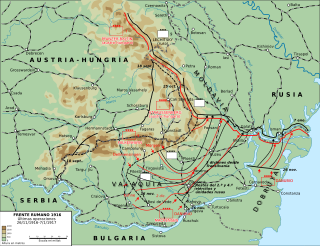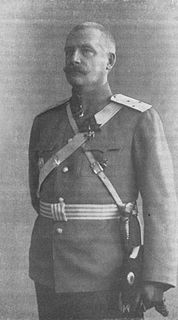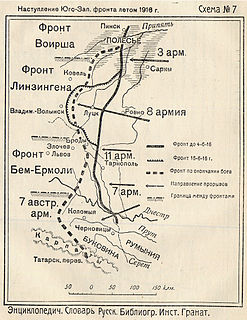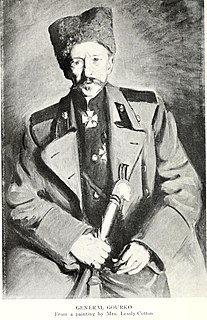The Stavka was the high command of the armed forces in the Russian Empire and the Soviet Union. In Imperial Russia Stavka refers to the administrative staff, and to the General Headquarters in the late 19th Century Imperial Russian armed forces and subsequently in the Soviet Union. In Western literature it is sometimes written in uppercase (STAVKA), which is incorrect since it is not an acronym. Stavka may refer to its members, as well as to the headquarter location.

An army group is a military organization consisting of several field armies, which is self-sufficient for indefinite periods. It is usually responsible for a particular geographic area. An army group is the largest field organization handled by a single commander—usually a full general or field marshal—and it generally includes between 400,000 and 1,000,000 soldiers.

The Russian Caucasus Army of World War I was the Russian field army that fought in the Caucasus Campaign and Persian Campaign of World War I. It was renowned for inflicting heavy casualties on the opposing forces of the Ottoman Empire, particularly at the Battle of Sarikamish. It was also known for its extremely diverse ethnic composition, consisting of units from throughout the Russian Empire and both soldiers and officers from the many ethnic communities settled since the 1877-78 Russo-Turkish War in the militarily administered Kars Oblast in the Russian Transcaucasus. These included Georgians, Caucasus Greeks, and Armenians - the latter in particular strongly represented among both the soldiers and senior officers - as well as ethnic Russians and Ukrainians.
The Russian Sixth Army was a World War I Russian field army that fought on the Eastern theatre of war.

The Romanian Front was a joint formation of the Imperial Russian Army and the Romanian Army during the First World War.

The Northern Front was an army group of the Imperial Russian Army during the World War I. It was responsible for carrying out operations against the Central Powers along a front line that stretched 280 kilometers, from Riga in the north down to northern Belarus. It was established in August 1915 when the Northwestern Front was split into the Northern and Western Front following the Great Retreat, and existed until the demobilization of the Russian army in 1918 due to the unrest from the Russian Revolution. In 1917 it had a total troop strength of 1.4 million men.

The Southwestern Front was an army group of the Imperial Russian Army during World War I. During the conflict it was responsible for managing operations along a front line that stretched 615 kilometers, from what is now southern Belarus to northern Romania, and took part in such operations as the Battle of Galicia and the Brusilov Offensive. It was established in August 1914 and lasted throughout the war until the unrest caused by the Russian Revolution, at which point it was demobilized along with the rest of the Russian Army in early 1918. In total some two million troops had been under its command.
The Russian Fourth Army was a World War I Russian field army that fought on the Eastern Front.

The 10th Army was a field army of the Imperial Russian Army during the First World War.
The Russian 11th Army was a World War I Russian field army that fought on the Eastern theatre of war.

The Russian Eight Army was a World War I Russian field army that fought on the Eastern theatre of war.
The Russian 7th Army was a World War I Russian field army that fought on the Eastern theatre of war.

The Russian 12th Army was a World War I Russian field army that fought on the Eastern theatre of war.
The Russian Special Army was a World War I Russian field army that fought on the Eastern Front.
The 1st Don Cossack Division was a Don Cossack cavalry division of the Russian Imperial Army.
The 2nd Grenadier Division was an infantry unit in the Imperial Russian Army as part of the Grenadier Corps. Notable engagements of the division include the French invasion of Russia.

Vasily Yegorovich Flug was an Imperial Russian Army General of the Infantry. A career military officer, he served in the Boxer Rebellion, Russo-Japanese War, and World War I, before joining the White movement during the Russian Civil War. Like many other officers, he went into exile after the end of the Russian Civil War, initially moving to Yugoslavia. After World War II, Flug went to the United States, where he died.
The 4th Army was a field army of the Red Army during the Russian Civil War, which was formed 4 times between the beginning of March 1918 and March 1921.












